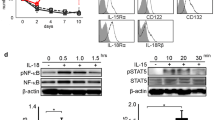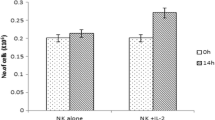Abstract
Natural killer (NK) cells have been well known to play a critical role in innate immunity, but they are also capable of regulating adaptive immunity through the induction of T cell-mediated memory response and B cell-mediated autoimmune response. NK cells are differentiated from hematopoietic stem cells (HSCs) in the bone marrow (BM), and a series of surface molecules are expressed on NK cells in a differentiation stage-specific manner. Axl receptor tyrosine kinase is originally identified as homeostatic regulators for antigen-presenting cells, and its ligand, growth-arrest-specific gene 6 (Gas6), has been reported to promote cell survival, proliferation, and migration, but their regulatory role in the development and effector function of NK cells is not yet fully understood. In this study, to investigate whether Axl is required for the regulation of NK cell development, the expression of mature NK (mNK) cell-specific receptors and NK cell-associated genes was analyzed in the differentiated HSCs-derived NK cells in vitro and the NK cells harvested from Axl−/− mice. We found that agonistic anti-Axl antibody or recombinant Gas6 specifically upregulated the expression of mNK cell-specific receptors, such as LY49A, Ly49G2, Ly49C/F/I, NKG2A/C/E (1.5- to 3.5-fold increase), and NK cell-associated genes, such as IL-2Rβ (2.3- or 2.4-fold increase), Perforin (4.1- or 2.1-fold increase), IL-15Rα (2.14- or 2.04-fold increase), and IFN-γ (3.3- or 2.8-fold increase) compared to each isotype control, whereas it was abrogated by treatment of Axl-Ig. Anti-Axl antibody or rGas6 also induced a 2.5- or 1.9-fold increase in the proliferation of developing NK cells compared to each control, respectively. mNK cell populations expressing mNK cell-specific receptors were reduced about twofold in NK cells differentiated from HSCs of Axl−/− mice compared with those of wild-type mice. Furthermore, the triggering of Axl signaling by agonistic anti-Axl antibody promoted the cytolytic activity (1.5- to 1.9-fold increase) against target tumor cells. In B16F10 melanoma-bearing mice, the number of metastatic colonies was decreased by 83 % by the administration of mNK cells treated with anti-Axl antibody compared to control Ig. These data suggest that Axl plays an essential role in the regulation of NK cell development as well as NK effector function.






Similar content being viewed by others
References
Briard D, Brouty-Boye D, Azzarone B, Jasmin C (2002) Fibroblasts from human spleen regulate NK cell differentiation from blood CD34(+) progenitors via cell surface IL-15. J Immunol 168:4326–4332
Bryson JS, Flanagan DL (2000) Role of natural killer cells in the development of graft-versus-host disease. J Hematother Stem Cell Res 9:307–316
Caraux A et al (2006) Natural killer cell differentiation driven by Tyro3 receptor tyrosine kinases. Nat Immunol 7:747–754
Cerwenka A, Lanier LL (2001) Natural killer cells, viruses and cancer. Nat Rev Immunol 1:41–49. doi:10.1038/35095564
Crosier KE, Crosier PS (1997) New insights into the control of cell growth; the role of the Axl family. Pathology 29:131–135
Douagi I, Colucci F, Di Santo JP, Cumano A (2002) Identification of the earliest prethymic bipotent T/NK progenitor in murine fetal liver. Blood 99:463–471
Fantl WJ, Johnson DE, Williams LT (1993) Signalling by receptor tyrosine kinases. Annu Rev Biochem 62:453–481
Godowski PJ, Mark MR, Chen J, Sadick MD, Raab H, Hammonds RG (1995) Reevaluation of the roles of protein S and Gas6 as ligands for the receptor tyrosine kinase Rse/Tyro 3. Cell 82:355–358
Goruppi S, Ruaro E, Schneider C (1996) Gas6, the ligand of Axl tyrosine kinase receptor, has mitogenic and survival activities for serum starved NIH3T3 fibroblasts. Oncogenes 12:471–480
Goruppi S, Chiaruttini C, Ruaro ME, Varnum B, Schneider C (2001) Gas6 induces growth, beta-catenin stabilization, and T-cell factor transcriptional activation in contact-inhibited C57 mammary cells. Mol Cell Biol 21:902–915
Graham DK, Deryckere D, Davies KD, Earp HS (2014) The TAM family: phosphatidylserine sensing receptor tyrosine kinases gone awry in cancer. Nat Rev Cancer 14:769–785. doi:10.1038/nrc3847
Healy AM, Schwartz JJ, Zhu X, Herrick BE, Varnum B, Farber HW (2001) Gas 6 promotes Axl-mediated survival in pulmonary endothelial cells. Am J Physiol Lung Cell Mol Physiol 280:L1273–L1281
Held W, Kunz B, Lowin-Kropf B, van de Wetering M, Clevers H (1999) Clonal acquisition of the Ly49A NK cell receptor is dependent on the trans-acting factor TCF-1. Immunity 11:433–442
Iizuka K, Chaplin DD, Wang Y, Wu Q, Pegg LE, Yokoyama WM, Fu YX (1999) Requirement for membrane lymphotoxin in natural killer cell development. Proc Natl Acad Sci USA 96:6336–6340
Kang HS et al (2005) Stage-dependent gene expression profiles during natural killer cell development. Genomics 86:551–565. doi:10.1016/j.ygeno.2005.06.010
Lee KN et al (2005) VDUP1 is required for the development of natural killer cells. Immunity 22:195–208. doi:10.1016/j.immuni.2004.12.012
Lian RH, Kumar V (2002) Murine natural killer cell progenitors and their requirements for development. Semin Immunol 14:453–460
Manfioletti G, Brancolini C, Avanzi G, Schneider C (1993) The protein encoded by a growth arrest-specific gene (gas6) is a new member of the vitamin K-dependent proteins related to protein S, a negative coregulator in the blood coagulation cascade. Mol Cell Biol 13:4976–4985
Moretta A, Bottino C, Mingari MC, Biassoni R, Moretta L (2002) What is a natural killer cell? Nat Immunol 3:6–8. doi:10.1038/ni0102-6
Myers SH, Brunton VG, Unciti-Broceta A (2015) AXL inhibitors in cancer: a medicinal chemistry perspective. J Med Chem. doi:10.1021/acs.jmedchem.5b01273
Neubauer A et al (1994) Expression of axl, a transforming receptor tyrosine kinase, in normal and malignant hematopoiesis. Blood 84:1931–1941
O’Bryan JP et al (1991) Axl, a transforming gene isolated from primary human myeloid leukemia cells, encodes a novel receptor tyrosine kinase. Mol Cell Biol 11:5016–5031
Paolino M et al (2014) The E3 ligase Cbl-b and TAM receptors regulate cancer metastasis via natural killer cells. Nature 507:508–512. doi:10.1038/nature12998
Park IK, Giovenzana C, Hughes TL, Yu J, Trotta R, Caligiuri MA (2009) The Axl/Gas6 pathway is required for optimal cytokine signaling during human natural killer cell development. Blood 113:2470–2477. doi:10.1182/blood-2008-05-157073
Rajaram N, Tatake RJ, Advani SH, Gangal SG (1990) Natural killer and lymphokine activated killer cell functions in Hodgkin’s disease. Br J Cancer 62:205–208
Ranson T, Vosshenrich CA, Corcuff E, Richard O, Muller W, Di Santo JP (2003) IL-15 is an essential mediator of peripheral NK-cell homeostasis. Blood 101:4887–4893. doi:10.1182/blood-2002-11-3392
Street SE, Trapani JA, Macgregor D, Smyth MJ (2002) Suppression of lymphoma and epithelial malignancies effected by interferon gamma. J Exp Med 196:129–134
Ullrich A, Schlessinger J (1990) Signal transduction by receptors with tyrosine kinase activity. Cell 61:203–212
Williams NS, Klem J, Puzanov IJ, Sivakumar PV, Bennett M, Kumar V (1999) Differentiation of NK1.1+, Ly49+ NK cells from flt3+ multipotent marrow progenitor cells. J Immunol 163:2648–2656
Williams NS, Kubota A, Bennett M, Kumar V, Takei F (2000) Clonal analysis of NK cell development from bone marrow progenitors in vitro: orderly acquisition of receptor gene expression. Eur J Immunol 30:2074–2082
Wimmel A, Glitz D, Kraus A, Roeder J, Schuermann M (2001) Axl receptor tyrosine kinase expression in human lung cancer cell lines correlates with cellular adhesion. Eur J Cancer 37:2264–2274
Acknowledgments
This research was funded by the Basic Science Research Program through the National Research Foundation of Korea (NRF) funded by the Ministry of Science, the ICT & Future Planning (NRF-2015R1A2A2A01007855), and the Ministry of Education, Science and Technology (NRF-2012R1A1A2004948).
Author information
Authors and Affiliations
Corresponding author
Ethics declarations
Conflict of interest
The authors declare that they have no conflict of interest.
Ethical approval
All of the mice were housed in a specific pathogen-free environment, and the animal experiments were performed in accordance with the guidelines of Chonnam National University.
Additional information
Handling Editor: Christos D. Katsetos
Eun-Mi Kim and Eun-Hee Lee contributed equally to this work.
Rights and permissions
About this article
Cite this article
Kim, EM., Lee, EH., Lee, HY. et al. Axl signaling induces development of natural killer cells in vitro and in vivo. Protoplasma 254, 1091–1101 (2017). https://doi.org/10.1007/s00709-016-1016-5
Received:
Accepted:
Published:
Issue Date:
DOI: https://doi.org/10.1007/s00709-016-1016-5




